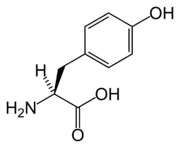| Tyrosinemia type II | |
|---|---|
| Other names | Oculocutaneous tyrosinemia,[1] Richner-Hanhart syndrome[2][1]: 543 |
 | |
| Tyrosine | |
| Specialty | Dermatology |
| Causes | Genetic (autosomal recessive)[3] |
Tyrosinemia type II is an autosomal recessive condition with onset between ages 2 and 4 years, when painful circumscribed calluses develop on the pressure points of the palm of the hand and sole of the foot.[4]: 512
Pathophysiology
Type II tyrosinemia is caused by a deficiency of the enzyme tyrosine aminotransferase (EC 2.6.1.5), encoded by the gene TAT. Tyrosine aminotransferase is the first in a series of five enzymes that converts tyrosine to smaller molecules, which are excreted by the kidneys or used in reactions that produce energy. This form of the disorder can affect the eyes, skin, and mental development. Symptoms often begin in early childhood and include excessive tearing, abnormal sensitivity to light (photophobia), eye pain and redness, and painful skin lesions on the palms and soles. About half of individuals with type II tyrosinemia are also mentally disabled. Type II tyrosinemia occurs in fewer than 1 in 250,000 individuals.[5]

Diagnosis
Diagnosis is made based on elevated plasma tyrosine level with skin or eye lesions.
Treatment
Dietary restrictions of phenylalanine and tyrosine.
See also
References
- 1 2 James WD, Elston DM, Berger TG, Andrews GC (2005). Andrews' Diseases of the Skin: Clinical Dermatology (10th ed.). Saunders. ISBN 0-7216-2921-0.
- ↑ Zea-Rey AV, Cruz-Camino H, Vazquez-Cantu DL, Gutiérrez-García VM, Santos-Guzmán J, Cantú-Reyna C (27 November 2017). "The Incidence of Transient Neonatal Tyrosinemia Within a Mexican Population" (PDF). Journal of Inborn Errors of Metabolism and Screening. 5: 232640981774423. doi:10.1177/2326409817744230.
- ↑ "Tyrosinemia type 2". Genetic and Rare Diseases Information Center (GARD) – an NCATS Program. Retrieved 24 August 2019.
- ↑ Freedberg IM, Fitzpatrick TB (2003). Fitzpatrick's Dermatology in General Medicine (6th ed.). McGraw-Hill. ISBN 0-07-138076-0.
- ↑ "Tyrosinemia Type II". Myriad Women's Health. Retrieved 14 October 2020.